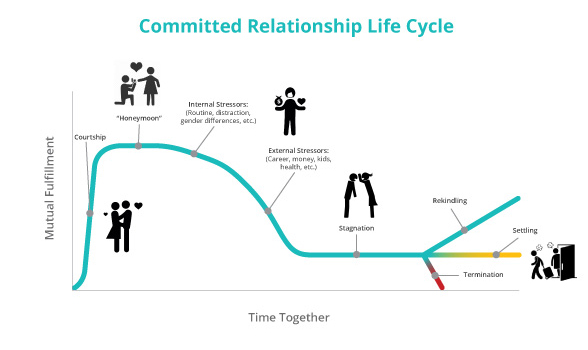The (Almost) Inevitable Relationship Life Cycle

Why most relationships simply won’t make it and how to avoid that fate…
– – –
See the author’s TEDx Talk on Creating Extraordinary Intimacy in a Shut Down World
– – –
As is turns out, most committed relationships travel through a fairly predictable arc with respect to changes in partners’ mutual fulfillment over time. And if they make it long enough to reach retirement there are two basic outcomes: a rekindling of their intimacy or “failure” reflected in either physical separation or just settling. Unfortunately, the failure mode is by far the likely outcome for most couples. This is because there are powerful innate forces that impact every aspect of every relationship. Forces that, if left unchecked, practically guarantees they will eventually lose the mutual fulfillment that brought them together in the first place.
Thankfully, there is a way to avoid this near inevitability. However, it first requires being aware of these inherent influences on your relationship. Then taking appropriate steps to repurpose their energy in a way that results in substantially increased fulfillment the longer you are together. I know, this is a very bold claim –but stay with me on this…
Six Stages of the Relationship Life Cycle
For every committed (i.e. long-term) relationship, there are six primary stages that impact partners’ experience of mutual fulfillment as depicted in the following chart:
Here is a more detailed explanation of each stage:
- Courtship – this is the exciting “getting to know each other” stage. This is typically experienced as an exciting adventure often accompanied with the potential promise of a wonderful and fulfilling life together.
- Honeymoon – assuming courtship leads to commitment, couples enter into the well-known honeymoon stage. For the vast majority of couples, this represents the pinnacle of their mutual fulfillment and can last anywhere from a few weeks to a couple of years.
- Internal Stressors – once the thrill of the honeymoon period wears off, routine, distraction and gender differences start to erode mutual fulfillment. I call these internal stressors because they are something each partner has control over once they are aware of them.
- External Stressors – significant further diminishment of mutual satisfaction can occur when the relationship is impacted by external stressors such as career, finances, health issues, and most notably, having children. Without appropriate checks in place, these have the potential of creating deep emotional wounding between the partners with a subsequent and proportional impact to their sense of mutual fulfillment. Clearly, it is very possible (and common) to experience high levels of personal fulfillment surrounding one’s children, career etc. while your committed partnership is far less than desired. In fact, a big trap is to focus on external fulfillment as a distraction or replacement for lack of fulfillment within one’s intimate relationship.
- Stagnation – this is the stage where partners just keep things together as best as they can hopefully long enough for the external stressors to pass (i.e. retirement, kids leave home, etc.) This is also often the most likely stage where couple’s therapy is sought to address long-brewing conflicts and the lack of intimacy and fulfillment.
- Maturation – in most cases, this represents the final stage of the relationship and has three possible outcomes:
- Rekindling – this is where the partners re-ignite the love and passion they had during earlier stages of their relationship leading to incrementally greater levels of mutual fulfillment. However, this rarely leads to achieving the same degree of fulfillment as experienced during the honeymoon stage.
- Settling – this is one version of relationship failure where couples stay together out of convenience. Either for financial reasons or unwillingness to get out of their comfort zone that would inevitably happen during a breakup.
- Termination – this is the second version of relationship failure where a couple decides to no longer be together primarily due to unresolvable conflict and deep emotional wounding.
It is important to note that the Maturation stage can occur any time after the honeymoon stage of the relationship cycle. Also, both internal and external stressors impacting relationships are cumulative and ongoing. For example, just because a couple transitions from internal stressors to external ones doesn’t mean the internal ones go away. In fact, unless proactively addressed, they only tend to become more deleterious over time.
Of course, all of this begs the question as to why most committed relationships seem to follow this progression. And, is there anything that can be done to interrupt this apparent fait accompli?
The Default Human Sexual Operating System
The default human Sexual Operating System (S.O.S.) is a collection of genetic and culturally based drives, beliefs and behaviors, primarily for the purpose and support of procreation, that has significant influence on nearly all aspects of intimate relationships. It is a model of human intimate behavior that very successfully predicts the stages and potential outcomes of typical committed relationships. Its significant power to negatively impact relationship behavior and outcomes is due to our inherent procreative imperative –collective survival of the species. And this is whether children are desired or not.
Its impact on intimate relationships can be summed up this way:
The way men and women are biologically and culturally “wired”, which is primarily for propagation purposes, gets in the way of the deeper emotional, physical and spiritual intimacy their hearts yearn for.
Essentially, most couples enter into committed relationships to achieve a deep sense of connection (i.e. intimacy) on all levels, only to be waylaid by the largely unconscious influence of the default S.O.S.
The value of a good model doesn’t end with its predictive powers. It should also provide insight on how to achieve positive outcomes. In this case, this means having a committed relationship in which mutual fulfillment continues to improve over time, rather than diminish.
Fortunately, the Sexual Operating System model provides us with this ability…
Imagine Your Honeymoon as the Starting Point of Mutual Fulfillment
What I am about to share with you next may be difficult to accept. However, I assure you that not only is it possible, my Partner and I are living proof of it. We have been together now for nearly four years (well beyond the typical honeymoon period) and our sense of mutual fulfillment on all levels (emotional, sexual and spiritual) only continues to increase.
As incredible as our honeymoon period was, it actually represents the low point of our mutual fulfillment. The following chart illustrates our continuing experience:
And, this is not by accident. We very consciously and assiduously apply our knowledge of the default S.O.S. to the point we able to “upgrade” it. Essentially, by upgrading our S.O.S. we have learned to leverage these inherent drives and modify our beliefs and behaviors resulting in a virtuous spiral of steadily increasing mutual fulfillment. This doesn’t imply we are immune to internal and external stressors. It simply means we have learned, thanks to our understanding of the default S.O.S., how to mitigate them before they cause any lasting damage.
You can learn more about what we did to achieve this in the following articles. They delve more deeply into the human Sexual Operating System model and how to leverage it for maximum sustainable fulfillment within your own relationship:
- Maslow and Your S.O.S. (Sexual Operating System)
- How to Upgrade Your Sexual Operating System for Maximum Fulfillment
- Making Love with an Upgraded Sexual Operating System
Your Relationship Firewall
The Sexual Operating System model of human intimate behavior represents a powerful and fundamental breakthrough concerning committed relationships. It is most effective however for those relationships that have yet to experience significant emotional wounding. In other words, it is best used to prevent this wounding in the first place and provide a path to ever-increasing levels of mutual fulfillment. It is not well suited to “fix” broken relationships wracked by deep divides which typically requires intensive couples’ therapy.
Think of it this way. By learning about your S.O.S. and how to upgrade it you essentially create a nearly impenetrable “firewall” protecting your relationship from ultimate failure (either settling or breakup). And, you set yourselves up for levels of emotional and sexual fulfillment that most couples can barely imagine possible.
The key, however, is not to wait until the fires of relationship wounding already start consuming the most important and fulfilling experience of your life.
– – –
About the Author
Michael J. Russer is a prostate cancer survivor who was left completely impotent as a result of his treatments. Yet, it was because of his impotence that he and his partner discovered an entirely new approach to emotional, physical and spiritual intimacy that far exceeds anything either experienced prior to when things were working “correctly.” His mission is to help men, women, and couples everywhere to achieve extraordinary intimacy on all levels.
He is an international speaker, author and thought leader on the issues of human connection and intimacy. He also speaks pro-bono to Cancer Support Centers and Gilda’s Clubs around the U.S. for cancer survivors and their partners about regaining intimacy in the face of cancer. Go to MichaelRusserLive.com to explore the possibility of having Michael speak at your next event.
Michael is also a champion of the nonprofit men’s work being done by the ManKind Project (MKPUSA.org). He completed the New Warrior Training Adventure in 2012.
Website: MichaelRusserLive.com
iTunes: Creating Extraordinary Intimacy in a Disconnected World
TEDx Talk: https://www.youtube.com/watch?v=XK8f8w7ICng



